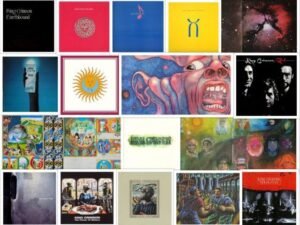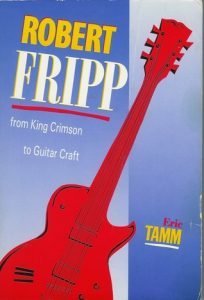Browse in the Library:
King Crimson – Red (Guitar sheet music)

“Red” (1974), a gift from King Crimson to our senses
A capital album of progressive rock and, if we hurry, of popular music. Red by King Crimson is an album praised both by the progressive scene and by other currents, such as heavy metal, grunge and alternative scenes.
It was recorded at Olympic ‘s London studios , and it was Monday, July 8, 1974, when the band entered the studios for what would be their last job in the seventies. The last one before Robert Fripp decided it was the end of this incarnation of King Crimson.
Background Network
Ian McDonald recalls: “I think John Wetton felt the group was ready for their ‘big moment.’ He felt that the group was, for the first time, about to become very popular » .
But the iconoclastic Fripp didn’t have that in mind. “I never let King Crimson fall into the success trap,” he said. “Several times we came very close to having a gigantic commercial success. I have always instinctively tried to avoid this success.”
Red by King Crimson is one of those albums that expresses the ultimate goal of a music group, the epitome of a paradigm, everything that has always been dreamed of and pursued.
Best Sheet Music download from our Library.
Not surprisingly, after Red , King Crimson disbanded and didn’t reappear for another six years. A new formation, a totally renewed style and a substantially different paradigm, certainly. After a record like Red , anything ran the serious risk of sounding trivial.
John Wetton perfectly summed up King Crimson’s mood in preparing for Red : “We were a heavy metal band back then, really . ”
English engineer George Chkiantz , who had already worked with King Crimson on Starless and Bible Black , was brought back for the preparation of Red . In studio two of the Olympic , all the necessary alchemy was given to create this sound monument.
John Wetton had a preference of plugging his bass directly into the mixer, which is why he spent the most time in the control room with George. Bill Bruford’s drums took up the right side of the studio, sounding more powerful and articulate than ever.
All of this made it clear that this work was going to be the band’s most powerful album. Undeniably and convincingly, Red captured the energy and telepathic power that King Crimson had to live.
Right from the first notes, with the mythical Red (which was the first piece they rehearsed), the listener realizes that it is a record with a lot of body and presence.
This is a song composed entirely by Robert Fripp, who, for some reason, was not convinced by Bill Bruford, and only at the insistence of Fripp and Wetton was it practiced. Bruford recalls that the composition reminded him of a number called Tea for Two , from 1924, composed by Vincent Youmans.
Please, subscribe to our Library. Thank you!
With powerful riffs, a full-throttle bass and Bruford’s mastery, it’s a kind of telluric movement that stirs every cell in us. The main riff had been rehearsed at a group soundcheck in Salt Lake City, and some sections of the theme had been part of the group’s natural and electrifying live improvisations. But it wasn’t until they were at the Olympic that Red took his final form.
Impressed with the energy of the track, Wetton recalls that a song called “Blue” was discussed but came to nothing. According to Fripp, the manuscript with the notes on this potential theme is still in his possession, and he had presented it in earlier rehearsals, but it was a dead end.
It should be noted that a cello section (played by Julian Lloyd Weber ) originally contained another section, removed by Fripp, which resurfaced 21 years later on “VROOOM VROOOM” from the Thrak album .
The delicate yet energetic epic Fallen Angel shows us the last time Fripp played an acoustic guitar on a Crimson King record. Here are a couple of guests who give a different dimension to the theme: cornetist Mark Charig and Robin Miller on oboe, who had already participated in two previous King Crimson albums ( Lizard and Islands ).
The lyrics, composed by Wetton and Supertramp founding member Richard Palmer-James , tell of the lament of a man who experiences the tragedy of watching his brother join a street gang, only to be stabbed to death on the streets of New York.

Sections of the Fallen Angel melody were played live two years earlier, in October 1972, when it was part of an Easy Money intro of sorts. The energy is still at its peak with Bruford laying down some electric jams, and Wetton and Fripp creating labyrinthine vortices of sound.
One More Red Nightmare brings us a big surprise: the fleeting return of Ian McDonald, a member of the first incarnation of King Crimson. McDonald, with his art, drew beautiful brushstrokes of sounds, while Fripp was concerned with building the textures of the theme. If Wetton and Bruford were looking for someone to challenge them and compete with them in this huge cathedral of sounds they created, it was Ian.
Fripp had played the riff on the theme improvised at past concerts (for example, at Toronto’s Massey Hall). This riff was later rehearsed in the studios to arrive at the final composition of the theme. Wetton’s voice on One More Red Nightmare developed a lot of expansion, as he felt more confident in how his range and performance projected, thus giving him greater comfort.
The next track in this masterpiece is Providence , which is an improvisation recorded on June 30, 1974 at the Palace Theater in the city that gives this piece its title. We can hear the telepathic ability that the band had live to create true jewels out of nothing. For eight minutes, we can listen to how Fripp, Bruford, Wetton and David Cross give life to a melody that comes from somewhere evolved.
The beginning of this improvisation is atmospheric, magical, dramatic in certain aspects, due to the dissonant melodic game that Cross and Fripp perform on the mellotron, to give way to Wetton’s enormous and imposing bass and the vortex of Bruford’s percussion. What we hear on the album is an excerpt from the improvisation that we could only fully enjoy on the box set released in 1992 called The Great Deceiver and on disc 19 of another box set: The Road to Red , released in 2013.
We come to the end of Red with a theme that is quintessential King Crimson. a track that goes from sublime contemplation to a state of melodic chaos: that marvel called Starless . A theme written in its chords and melody by John Wetton, and which was initially rejected by Fripp and Bruford. In fact, it had been created in the Starless and Bible Black sessions.
However, it was revived for this record with new lyrics, undergoing several revisions and with the contribution of Palmer James. It also incorporated a bass riff created by the master Bruford.
They participate in the song, again, Ian McDonald and an old acquaintance, Mel Collins . In the initial stage of Starless , the introduction was done by David Cross, later to be performed by Fripp on guitar, adding minimal changes to what Cross had done (although live the latter performs the original introduction on violin and Fripp is on the mellotron).
Describing what triggers this sensory work of art is difficult to explain; It is like being touched by an energy that caresses us and then throws us into the abyss, only to be reborn from the ashes like a phoenix. Starless at times excites us and at the same time invites us to discover the darker side of the crimson king. Bruford’s suffocating drumming produces a wave of Machiavellian happiness that climaxes at 7:58 with that galactic Chinese cymbal break.
What else can be said about Starless? Only that it’s an epic ending to a cathedral-like record, and that it would be the full stop for this incarnation.
We let ourselves fall into the maelstrom, death and sunset, light and darkness… in short, in the life of this more than essential gift to the senses that King Crimson with Red gives us.
